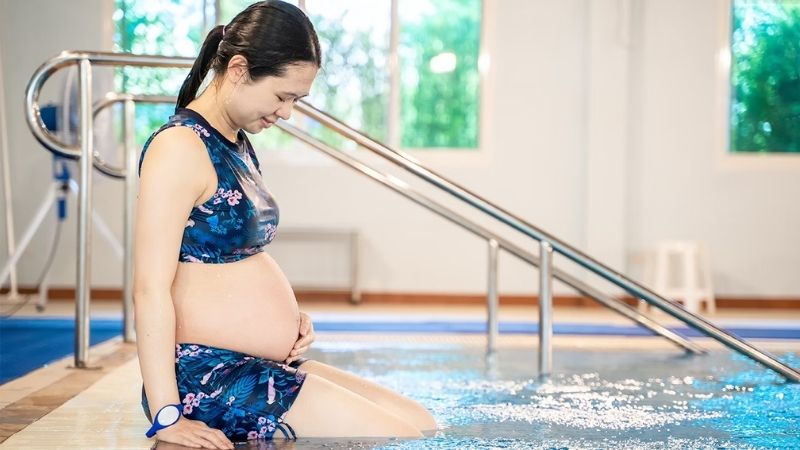Giving birth is a special moment in every woman’s life. However, the birthing process can be painful and difficult. Therefore, expectant mothers can engage in some simple sports to enhance their health, reduce discomfort, and make the birthing process smoother. In this article, let’s explore 3 sports that help mothers give birth quickly and reduce pain.
1 Yoga
brings many wonderful benefits to expectant mothers, especially in balancing the body and mind. Regular yoga practice helps the body become flexible, supple, and healthy, while minimizing symptoms such as swollen feet, leg edema, and back pain.
In addition, yoga also supports expectant mothers in emotional balance, reducing stress and bringing a positive mindset. Yoga also helps the expectant mother’s mind feel more comfortable, increases work productivity, and prevents fatigue.
Prior to practicing yoga, expectant mothers should consult with a doctor to ensure safety for both mother and baby. In the case of no health issues, expectant mothers can start practicing yoga from the moment they discover their pregnancy. However, expectant mothers should wait until the 12th week of pregnancy to start practicing yoga, as the first 3 months are usually sensitive and have movement limitations due to morning sickness.
Here are some yoga poses that expectant mothers should avoid:
- Poses that are too difficult and not suitable for the expectant mother’s abilities.
- Pose that exerts pressure on the uterus, such as bending too much.
- Exercises with continuous rolling, standing up and sitting down quickly.
- Poses that involve putting the foot on the belly while standing.
- Breath-holding techniques, breathing quickly and forcefully.
- Forward abdominal exercises or abdominal compression, exerting pressure on the uterus.
During the yoga practice, expectant mothers should listen to their bodies and always respect their limits. If there are any abnormal signs, stop practicing and consult with a doctor.
 Yoga helps expectant mothers give birth quickly, reduce pain
Yoga helps expectant mothers give birth quickly, reduce pain
2 Walking
is a simple exercise that pregnant women can do at any time of the day. Walking is suitable for the middle and late stages of pregnancy when high-intensity exercises are no longer suitable.
Outdoor walking allows you to breathe fresh air, enjoy the morning sunlight, and is very good for the health of both the expectant mother and the baby. In addition, walking can stimulate uterine contractions and help the baby move closer to the lower part of the uterus, making the birthing process easier.
Experts evaluate that walking is the best cardiovascular exercise for pregnant women. Walking makes the knees and ankles more flexible, while providing comprehensive health benefits for expectant mothers. Performing exercises such as walking for about 30 minutes a day or more will help you give birth more easily and reduce risks for both the mother and baby. Walking also helps women who did not have the habit of exercising before pregnancy gradually get used to daily exercise.
If you have been regularly walking before pregnancy, try to maintain this habit during pregnancy. If you did not regularly exercise before, you can start by walking slowly, like taking a stroll for about 10-20 minutes a day.
Here are some notes when walking for expectant mothers:
- Choose low, well-fitting shoes with high ankle collars to protect the ankles and toes.
- Wear a hat with a brim on hot sunny days, especially in summer to avoid direct sunlight.
- Expectant mothers should start walking for 15-20 minutes a day and repeat regularly for 3 days a week. Then, you can increase to 5 minutes and 4 days a week. You can increase walking exercise to 5 days a week after a few weeks.
- In the late stage of pregnancy, avoid walking on long routes or uneven terrains, as this can cause imbalance and be dangerous.
 Walking helps expectant mothers give birth quickly, reduce pain
Walking helps expectant mothers give birth quickly, reduce pain
3 Swimming
is a gentle and beneficial exercise for pregnant women. Swimming for about 30 minutes a day before delivery will bring many benefits to both the expectant mother and the baby, including:
- Reducing swollen feet and ankles.
- Reducing sciatic nerve pain.
- Reducing nausea symptoms.
- Helping maintain appropriate weight throughout pregnancy.
When swimming, expectant mothers should pay attention to the following:
- Choose to swim in the cool afternoon, when the air is still warm and the body can easily adapt to the environment.
- Avoid swimming under intense sunlight or in the early morning, as the temperature difference between the body and the environment can cause dizziness and increase the risk of temperature-related diseases.
- Avoid swimming in polluted beaches or lakes, to reduce the risk of infection through water. Choose a swimming pool that is properly treated with chlorine to ensure hygiene and safety.
- Especially, avoid staying in hot water for too long, as high body temperature can be dangerous for the baby in the early stages of pregnancy.
- Be cautious when moving around the pool, as the pool floor is often slippery. Make sure you move carefully to avoid the risk of slipping.
- Maintain a steady and continuous breathing rhythm while swimming, to ensure sufficient oxygen supply to the baby.
- Don’t forget to stay hydrated. Although it doesn’t cause as much sweating as other exercises, swimming can cause dehydration. Drink about 500ml of water about two hours before exercising and always have a water bottle near the pool to drink during the practice.
 Swimming helps expectant mothers give birth quickly, reduce pain
Swimming helps expectant mothers give birth quickly, reduce pain
Yoga, walking, and swimming all bring significant benefits to expectant mothers. Hope this article provides useful solutions for you and helps your birthing process go smoothly.
Source: ttvn.toquoc.vn
Improving Children’s Vision Through Smartphone Use
As smartphones become an ever-increasing feature of our lives, parents are increasingly anxious about their effects on young eyes. To help them protect their children’s vision, DIEN MAY XANH has some tips on the safer use of Android phones for younger users. Recent research has linked the extended use of smartphones to Myopia, so being mindful of our tips could help to lower the risk of this sight-impairing condition. Read on to find out more about how to better protect your child’s eyesight.
Running vs Walking: Which is Better?
 Walking: Which is Better?’>
Walking: Which is Better?’>Cardiovascular exercise is crucial for overall health, and walking and running are two simple forms of cardiovascular exercise.





































